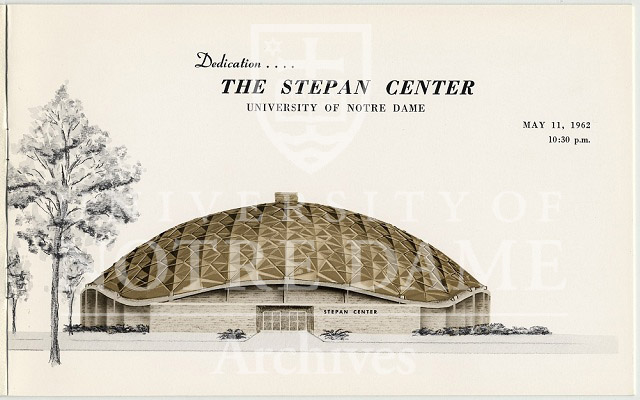
In the 1950s and 1960s, Notre Dame administrators and students were embracing modern architecture. They were turning their backs on what they considered to be old, stodgy buildings of the past and looking toward new designs.

“Mod Quad” began in 1962 with the geodesic dome Stepan Center, a bold architectural statement. Plans were made for five high-rise dormitories and the Cardinal O’Hara Chapel, with a space-age design. Flanner and Grace Halls were completed in 1969, but the plans for the rest of the buildings were eventually scrapped.

As early as 1947, there were plans to tear down Main Building, which was showing signs of needing serious repair and renovation. The idea was revisited in the early 1960s when the site of the Main Building was considered for the location of the new library. Fortunately, the administration eventually settled on the site just north of the Stadium where the current Hesburgh Library now resides. During this time, a number of students had little love loss over Main Building. In 1959, John Bellairs poked fun at the dilapidated Main Building, writing a fictitious account of the building collapsing after a janitor pulled out a loose brick (“Decline and Fall of Main Building,” Scholastic 03/20/1959).

In 1962, Sam Haffey also supported the idea of the demolition of Main Building, saying “I feel that the character relation of Renaissance dome to French chateau is slightly ridiculous, and that to treat them as an architectural beauty to be preserved forever is also slightly ridiculous” (“A New Campus, Maybe?” Scholastic, 11/09/1962). It wasn’t until the 1990s that the administration undertook extensive restoration of Main Building to preserve the historic building for generations to come.
Notre Dame’s Main Building is one of the most famous and widely recognizable buildings in the United States. Its image is so deeply ingrained in the identity of this University that it is difficult to fathom the idea that people once thought to remove it. Going into the 21st century, we moved back to preferring the traditional Collegiate Gothic look for our campus. Indeed, the University recently cleared out several utilitarian buildings of the modern architectural era, such as the University Club and the old Post Office. The architectural gem Stepan Center may not be far behind. Varied buildings on campus add character to the University and are a reminder of ever-changing architectural aesthetics.
Sources: Scholastic
A Dome of Learning: The University of Notre Dame’s Main Building by Thomas Schlereth
PNDP 10-St-3
GNDL 4/09A
UNDD: Notre Dame Architectural Drawings
